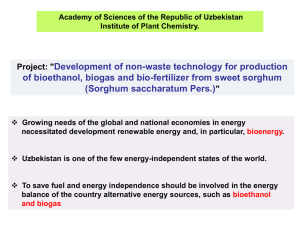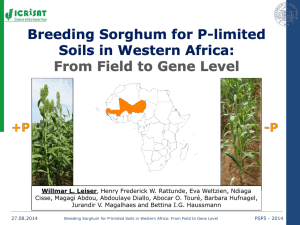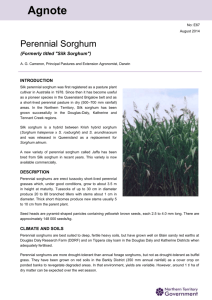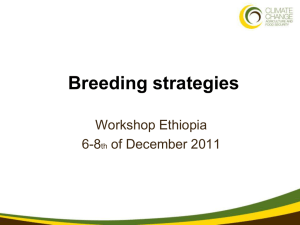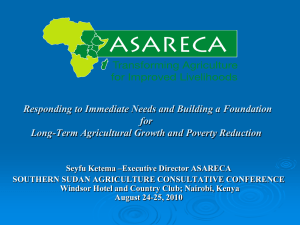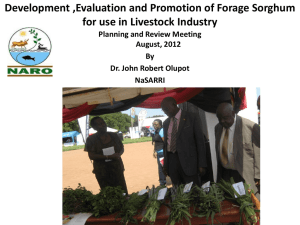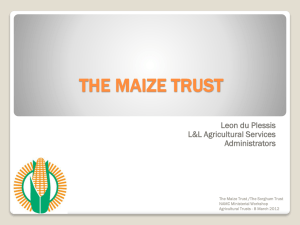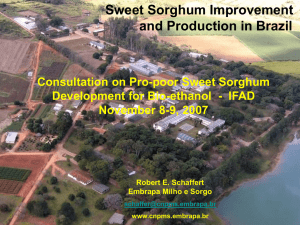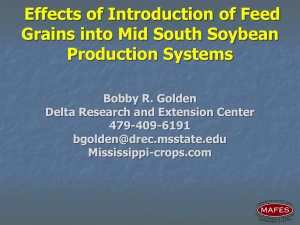KAPAP CGS COLLABORATIVE RESEARCH PROJECTS PI MEETING
advertisement
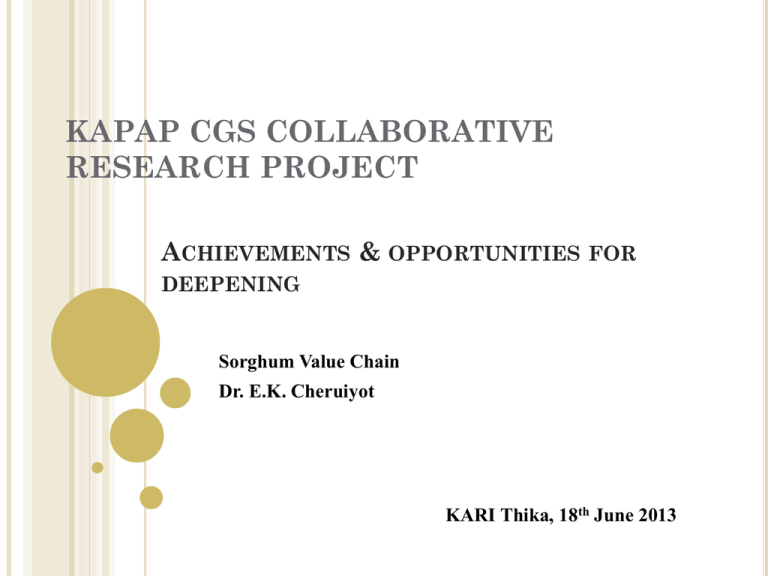
KAPAP CGS COLLABORATIVE RESEARCH PROJECT ACHIEVEMENTS & OPPORTUNITIES FOR DEEPENING Sorghum Value Chain Dr. E.K. Cheruiyot KARI Thika, 18th June 2013 Enhancing sorghum production, processing and marketing for improved small-holder incomes and livelihoods in Kenya Overall Project Objective To enhance sustainable sorghum production, processing and marketing for improved incomes and livelihoods in Kenya SPECIFIC OBJECTIVES 1) To improve small-holder sorghum production in Kenya 2) To link sorghum out-growers to a sustainable market 3) To enhance and promote sorghum post-harvest handling and processing 4) To increase marketing opportunities for sorghum and sorghum products 5) To avail and share information targeting different categories of stakeholders in the sorghum value chain 6) To develop an IPM model for sorghum value chain Collaborating Organizations Egerton University, Lead Organization University of Nairobi, JKUAT, Jaramogi Oginga Odinga University, SACRED Africa, KARI Biotechnology Centre Industrial partners East Africa Breweries Ltd (EABL) Spectre International Nakuru Pattisserie Bakery Focus of presentation Achievements Lessons learned Areas for deepening/up-scaling Project funding Total Project Cost - 3 Yrs; = (Ksh.) 23,955,300 Project Year 1 Cost; = (Ksh.) 11,046,150 Achievements for Year 1: • Site selection and identification of farmerworking groups Project working sites identified: Rift Valley – Nakuru; Njoro, Rongai, Kampi Ya Moto (and KARI Marigat), Nyanza - Spectre International (Kisumu) Eastern - Makueni; Kiboko, Kampi-ya-mawe and Kibwezi (Masongaleni) • Base line study to identify production constraints – Baseline on status and constraints in sorghum production done in Nakuru; covering Njoro and Rongai Districts; and Siaya District – Key outputs: Sorghum production is low, Constraints: i) access to seed and market, only 28% of farmers had easy access to sorghum seed, ii) High cost of inputs, credit facilities, post harvest technologies Opportunities: provision of improved sorghum varieties • Evaluate and identify genotypes for baking, brewing, ethanol production • Evaluated 31 hybrids and 60 Lowland OPV and 40 Highland OPV- for yield and suitability for baking, ethanol yield, malting & brewing. Genotypes for Baking • Identified genotypes: 5 for baking (at 12-16% sorghum in sorghumwheat flour) • Brown/red sorghum (the 5 best) • White sorghum (better among white sorghum) Genotypes for Ethanol • 25 sweet sorghum genotypes were evaluated for brix content & ethanol yield • 3 genotypes for ethanol extraction - from stalk juice (600-700 litres ethanol per ha) Sorghum stalk juice fermentation Genotypes for Malting & Brewing • 130 sorghum genotypes evaluated for malting and brewing • 2 identified for brewing (1hybrid = EU 27) Yield potential 6.23 t/ha ( 1OPV = EU 52) Yield potential 3.51 t/ha Set up community based seed multiplication and distribution centers – Initiated in Siaya, so far the farmers have produced 10 bags (≃ 1 ton) of Macia Develop and evaluate a cost effective method of threshing and cleaning sorghum grain – Portable Sorghum Thresher machine fabricated – Testing in the workshop done – Field use targeted (October – December) • Develop and test diverse products – Lab analysis on baking attributes of 46 genotypes complete – Results gave 5 best sorghum genotypes for bread – Nakuru Pattisserie Bakery to be supplied with grain to start baking and promotion of bread with consumers Marketing opportunities for sorghum products • Conduct market research – Market research done in Nakuru & Makueni • Training and capacity building – Training conducted on quality standards done in Nakuru & Makueni – Number of farmers trained were 72 in Makueni and 69 in Nakuru • Create linkages and partnerships on markets – Initiated with EABL, and Scared Africa is in the process of identifying other partners and markets • Develop and implement a quality control system – Training farmers on quality standards done with farmers in Nakuru & Makueni – Brochure on quality control developed – Quality control equipment to be given • Develop a storage and transport system – Each farmer-group to identify store, – Do branding, renovation before quality control equipment can be placed Sharing information targeting different categories of stake-holders in the sorghum value chain • Develop information materials such as brochures and fliers ▫ Some brochures produced and distributed, but this task is continuous • Hold demonstrations, workshops, conference and field days ▫ Demonstrations were set-up in each site during the two growing seasons (2011 & 2012), ▫ Field days conducted during the first season (2011) • Publication on research findings, produce policy briefs on sorghum ▫ 1 publication is out and 3 more in the review • Conduct Monitoring and Evaluation ▫ Continuous Overall Summary of Project Achievements of Year 1: • Establishment of base line information on sorghum production status in Siaya, Nakuru and Makueni: ▫ Key highlights Information ▫ low sorghum production ▫ constraints among them being access to market and quality seed. • Mobilization of farmer-groups ▫ knowledge sharing ▫ participate in collective production and marketing ▫ Farmer-training on farmer organization for better price bargains Summary Achievements cont • Evaluation of sorghum genotypes for targeted uses; (malting and brewing, baking and ethanol yield) completed ▫ A total of 130 for malting & brewing , and baking ▫ 25 sweet sorghum for ethanol yield ▫ Malting & Brewing = 18 potential, 8 submitted to EABL and 2 outstanding. ▫ Baking = out of 30 potential, 5 produced quality bread ▫ Ethanol = 25 evaluated and 3 potentially good with 600-700 litres ethanol per ha 2 Lessons Learned a) Socio-cultural issues influence uptake a technology – farmers with religious background opposed to cultivating sorghum for brewing b) Involving relevant stakeholders in development of technology hasten achievement of results c) Engaging students in project work hasten the achievement of results and enhanced quality of output. Future funding should consider a deliberate inclusion of Masters’ degree students with adequate support Lessons learned cont. • d) Confidence in engagement ; i) between project financiers and project implementers, and ii) amongst implementers (between collaborators). When flow of funds from KAPAP was temporarily halted, some collaborators in this work almost pulled out and their confidence went low. We have also realized that where there is close working relationship, substantial achievement have been registered and almost nil where a collaborator is less involved in the team. • This clearly show that there is need to cultivate and build confidence among all players. Future Plan • i) We plan to avail sorghum seed for the identified uses to both industry and farmers. Some are already in the National Performance Trial, but we hope KAPAP can facilitate our initiative to produce breeder seed as we await certification • ii) Sorghum bread need to be taken to the market. We are waiting for the entrepreneur to start production and will assist in promotion of the product • iii) Complete the other planned activities as scheduled in the proposal 3) Areas for Deepening/up-scaling • i) Sorghum seed production and availability • • Priority: ▫ EU 27, EU 52 ▫ EU 110, EU 121, ▫ EU 11, EU 10, EU 17 Strategy • Multiply and produce breeder and foundation seeds of identified genotypes to enhance seed availability • Bulk the seed as Quality Declared Seed and enhance adoption and access through linkages with stakeholders • Variety promotion – demonstration in major target catchment ii) Postharvest grain handling • Grain quality status is of concern for the industrial products entering market • Its acceptable quality standards should be upheld to allow for increase uptake in sorghum production and marketing • There is need to establish its quality status after harvesting and determine conditions likely to be detrimental, as a strategy for formulating acceptable postharvest handling technologies iii) Sorghum for feed • To address the need for feed under mixed farming set-up • It’s an emerging need for both livestock farmers and feed industry • Strategy: ▫ Link farmers with feed manufacturers ▫ Promote silage technology for sorghum Acknowledgment • • • • • KAPAP for financial support Collaborators and Industrial partners ICRISAT Ministry of Agriculture Egerton University and collaborating institutions for smooth implementation of the project THANK YOU
